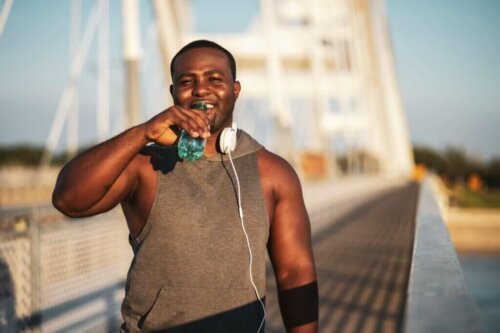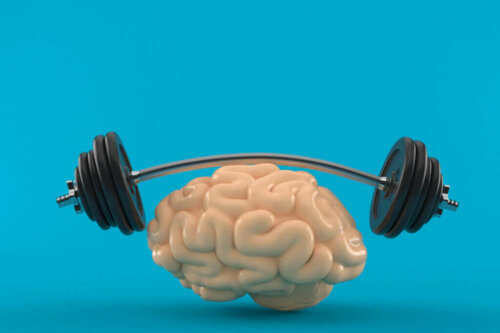Discover How to Train the Hamstrings
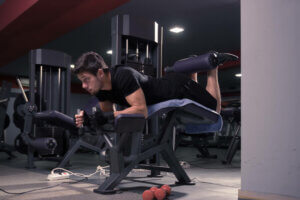
Anyone who goes to the gym regularly or practices a sports discipline probably knows many chest, shoulder, or abdominal exercises. However, many don’t know how to train the hamstrings. Which exercises can help you to train them?
To know how to train this muscle group, you first need to understand its anatomy. The hamstrings consist of the biceps femoris, the semimembranosus, and the semitendinosus muscles.
All of these muscles originate at the ischium and insert at the tibia. This muscle group is biarticular, as it passes through both the hip and knee joints.
Exercises to train the hamstrings
Although the hamstrings are knee flexors, they also act as hip extensors. Therefore, in order to train them, you must do exercises in which you flex your knees or extend your hips. Below, we’ll share a few of them!
Leg curl
There are different types of exercise machines to train the hamstrings. Experts recommend them, especially for those who don’t have much experience training at the gym. The exercise machine will guide the movement and there’ll be less chance of injury. However, that doesn’t mean that it isn’t a good idea for the most experienced.
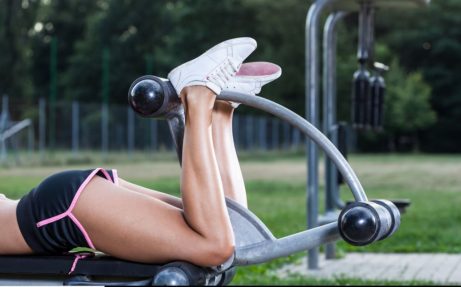
A common mistake people make when they do this exercise is starting with a powerful movement and forgetting to exert any type of force during the remaining reps. Instead, it’s best to maintain the same force during all the repetitions.
Train the hamstrings: Romanian deadlift with a barbell
This exercise is a classic free weight exercise. In this case, the hip joint is the one that’s worked the most. As its name implies, it’s a barbell exercise. Experts recommend beginners to support it on a rack.
Before doing the exercise, you must do a scapular retraction so your shoulders don’t fall forward. Once you’re in position, hold the barbell and elevate it, using a hip extension.
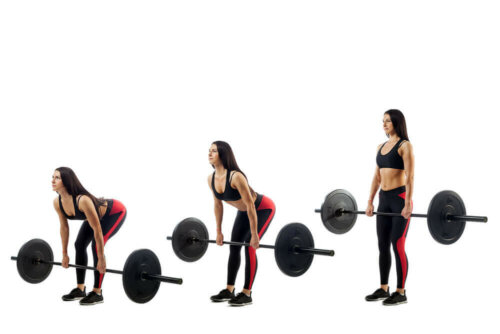
It’s important for your knees to be almost completely extended and seek hip anteversion during the elevation. This way, you can avoid lower back problems.
One of the most common mistakes people make with this exercise is trying to go as low as possible with the barbell, ultimately neglecting the exercise technique.
Hamstring curl with a resistance band
This exercise is quite practical, especially if you can’t work out at a gym. Firstly, tie the resistance band to a pole at a low height. To exercise both legs simultaneously, we recommend surrounding the pole with the resistance band to have two holds.
Then, you’ll have to lie face down and insert both legs into the holes of the resistance band. They should be around your ankles.
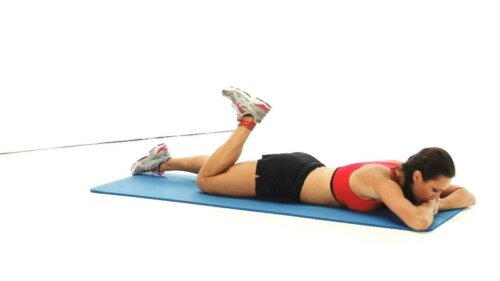
Once in position, you need to move away from the pole until the resistance band stretches to the desired tension. After that, bend your knees. In other words, bring your ankles closer to your buttocks.
Nordic hamstring curl
The journal Sports Medicine concluded that this exercise can reduce the risk of injury. This exercise trains the hamstrings eccentrically. Most people do this exercise with a partner. Firstly, if you’re the one who’s going to do the exercise, you must kneel.
It’s advisable for you to place a mat underneath to avoid affecting your joints. Your partner needs to stand behind you and will be responsible for holding your feet to the ground.
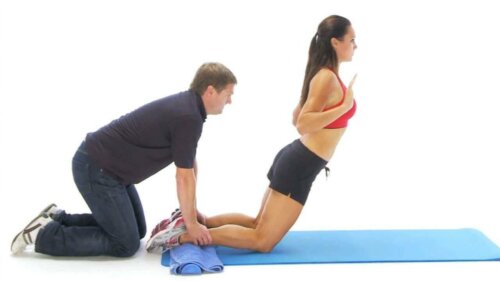
For safety reasons, you must place your hands at your chest and face the front in order to cushion the fall. Before starting, it’s important for you to activate your core and glutes so that your body is a single unit from head to toe.
This means that you can’t bend your hips. Once you’re ready, you must cause a minor anterior imbalance to try to descend progressively. The idea is to extend the descent as much as possible.
To cushion the fall, you need to use their hands. Then, push with your hands to recover the starting position. As the British Journal of Sports Medicine indicates, this exercise is a great way to train your lower body and can help prevent injury.
Train the hamstrings: exercise ball leg curl
To do this exercise, you first have to lie on your back and place the exercise ball under your calves. Your arms must be on the floor, parallel to your body. Next, elevate your hips.
Subsequently, bend your knees, bringing your feet closer to your buttocks, and then return to the starting position, but keeping your hips aligned at all times. If the exercise didn’t generate the desired tension, you can repeat it with one leg.
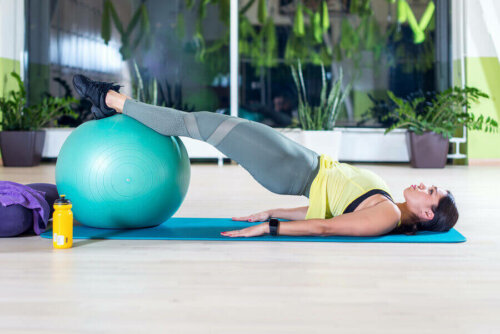
In short, remember that you can do any of these exercises to train the hamstrings. However, you should bear in mind that, although all of these exercises train this muscle group, they’re different from each other.
For this reason, we recommend consulting a professional so that they can plan an adequate routine for you and supervise you while you do the exercises.
Anyone who goes to the gym regularly or practices a sports discipline probably knows many chest, shoulder, or abdominal exercises. However, many don’t know how to train the hamstrings. Which exercises can help you to train them?
To know how to train this muscle group, you first need to understand its anatomy. The hamstrings consist of the biceps femoris, the semimembranosus, and the semitendinosus muscles.
All of these muscles originate at the ischium and insert at the tibia. This muscle group is biarticular, as it passes through both the hip and knee joints.
Exercises to train the hamstrings
Although the hamstrings are knee flexors, they also act as hip extensors. Therefore, in order to train them, you must do exercises in which you flex your knees or extend your hips. Below, we’ll share a few of them!
Leg curl
There are different types of exercise machines to train the hamstrings. Experts recommend them, especially for those who don’t have much experience training at the gym. The exercise machine will guide the movement and there’ll be less chance of injury. However, that doesn’t mean that it isn’t a good idea for the most experienced.

A common mistake people make when they do this exercise is starting with a powerful movement and forgetting to exert any type of force during the remaining reps. Instead, it’s best to maintain the same force during all the repetitions.
Train the hamstrings: Romanian deadlift with a barbell
This exercise is a classic free weight exercise. In this case, the hip joint is the one that’s worked the most. As its name implies, it’s a barbell exercise. Experts recommend beginners to support it on a rack.
Before doing the exercise, you must do a scapular retraction so your shoulders don’t fall forward. Once you’re in position, hold the barbell and elevate it, using a hip extension.

It’s important for your knees to be almost completely extended and seek hip anteversion during the elevation. This way, you can avoid lower back problems.
One of the most common mistakes people make with this exercise is trying to go as low as possible with the barbell, ultimately neglecting the exercise technique.
Hamstring curl with a resistance band
This exercise is quite practical, especially if you can’t work out at a gym. Firstly, tie the resistance band to a pole at a low height. To exercise both legs simultaneously, we recommend surrounding the pole with the resistance band to have two holds.
Then, you’ll have to lie face down and insert both legs into the holes of the resistance band. They should be around your ankles.

Once in position, you need to move away from the pole until the resistance band stretches to the desired tension. After that, bend your knees. In other words, bring your ankles closer to your buttocks.
Nordic hamstring curl
The journal Sports Medicine concluded that this exercise can reduce the risk of injury. This exercise trains the hamstrings eccentrically. Most people do this exercise with a partner. Firstly, if you’re the one who’s going to do the exercise, you must kneel.
It’s advisable for you to place a mat underneath to avoid affecting your joints. Your partner needs to stand behind you and will be responsible for holding your feet to the ground.

For safety reasons, you must place your hands at your chest and face the front in order to cushion the fall. Before starting, it’s important for you to activate your core and glutes so that your body is a single unit from head to toe.
This means that you can’t bend your hips. Once you’re ready, you must cause a minor anterior imbalance to try to descend progressively. The idea is to extend the descent as much as possible.
To cushion the fall, you need to use their hands. Then, push with your hands to recover the starting position. As the British Journal of Sports Medicine indicates, this exercise is a great way to train your lower body and can help prevent injury.
Train the hamstrings: exercise ball leg curl
To do this exercise, you first have to lie on your back and place the exercise ball under your calves. Your arms must be on the floor, parallel to your body. Next, elevate your hips.
Subsequently, bend your knees, bringing your feet closer to your buttocks, and then return to the starting position, but keeping your hips aligned at all times. If the exercise didn’t generate the desired tension, you can repeat it with one leg.

In short, remember that you can do any of these exercises to train the hamstrings. However, you should bear in mind that, although all of these exercises train this muscle group, they’re different from each other.
For this reason, we recommend consulting a professional so that they can plan an adequate routine for you and supervise you while you do the exercises.
All cited sources were thoroughly reviewed by our team to ensure their quality, reliability, currency, and validity. The bibliography of this article was considered reliable and of academic or scientific accuracy.
- Al Attar, W. S. A., Soomro, N., Sinclair, P. J., Pappas, E., & Sanders, R. H. (2017). Effect of injury prevention programs that include the nordic hamstring exercise on hamstring injury rates in soccer players: a systematic review and meta-analysis. Sports medicine, 47(5), 907-916.
- Bourne, M. N., Duhig, S. J., Timmins, R. G., Williams, M. D., Opar, D. A., Al Najjar, A., … & Shield, A. J. (2017). Impact of the Nordic hamstring and hip extension exercises on hamstring architecture and morphology: implications for injury prevention. British Journal of Sports Medicine, 51(5), 469-477.
- McAllister, M. J., Hammond, K. G., Schilling, B. K., Ferreria, L. C., Reed, J. P., & Weiss, L. W. (2014). Muscle activation during various hamstring exercises. The Journal of Strength & Conditioning Research, 28(6), 1573-1580.
- van der Horst, N., Smits, D. W., Petersen, J., Goedhart, E. A., & Backx, F. J. (2015). The preventive effect of the nordic hamstring exercise on hamstring injuries in amateur soccer players: a randomized controlled trial. The American journal of sports medicine, 43(6), 1316-1323.
This text is provided for informational purposes only and does not replace consultation with a professional. If in doubt, consult your specialist.





